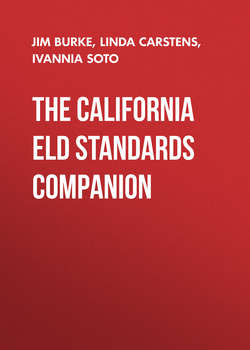Читать книгу The California ELD Standards Companion, Grades 3-5 - Jim Burke - Страница 25
На сайте Литреса книга снята с продажи.
Grades 3–5 Interacting in Meaningful Ways Collaborative Standard 1
ОглавлениеAcademic Vocabulary—Key Words and Phrases Related to Standard 1: Exchanging information and ideas
Affirming others: teacher or student comments that reflect a positive behavior (i.e., turn-taking) or a response or question from someone else in the conversation that exemplifies or clarifies the gist of the discussion
Asking relevant questions or adding pertinent information: teacher or student questions and/or comments that move forward the group’s understanding of the concepts being studied. These are usually open ended, and can be text dependent, clarifying, and/or making connections questions or comments (to oneself or others, to other texts, to other ideas).
Building on other’s responses: student comments that take into account what others have said in the discussion, and linking their comments to those points
Collaborative conversations: discussing ideas and working jointly with others to develop new thinking. Students take the remarks of others and add details or further develop the thoughts.
Multiple exchanges: discussions where one idea is considered and discussed by several persons, growing richer and more complex as new ideas or examples are added, instead of the typical question-answer, new question-answer pattern that limits discussion
Providing useful feedback: offering specific, helpful suggestions to a student in order to improve his or her thinking or work product. Examples include, “You did a good job on ______; I think you should ______ because it would help ______.”
Speaking audibly: to speak loudly enough to be heard but not so loudly as to be shouting or distorting the message
Sustained dialogue: collaborative conversations in which students create new thinking by working with others to add details or further develop thoughts on the topic of discussion
Turn-taking roles: various ways for students to consciously listen to others, say their contribution and then listen again. These roles can include Think-Pair-Share, Reciprocal Teaching, using Equity sticks, etc.
Using learned phrases: opportunities for students to share their ideas and thoughts by using patterns or prompts to frame their oral language. These can come from pattern drills, sentence frames, and other sources.
Source: ELA Companion 3–5.
Notes
___________________________________________________________________________________
___________________________________________________________________________________
___________________________________________________________________________________
___________________________________________________________________________________
___________________________________________________________________________________
